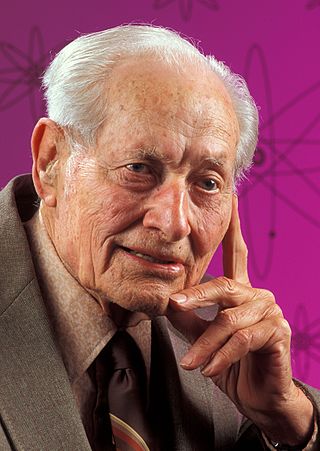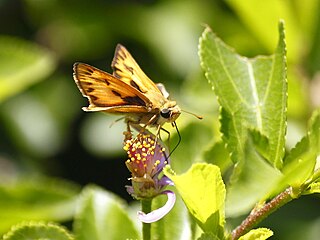
Entomology is the scientific study of insects, a branch of zoology. In the past the term "insect" was less specific, and historically the definition of entomology would also include the study of animals in other arthropod groups, such as arachnids, myriapods, and crustaceans. This wider meaning may still be encountered in informal use.

Integrated pest management (IPM), also known as integrated pest control (IPC) is a broad-based approach that integrates both chemical and non-chemical practices for economic control of pests. IPM aims to suppress pest populations below the economic injury level (EIL). The UN's Food and Agriculture Organization defines IPM as "the careful consideration of all available pest control techniques and subsequent integration of appropriate measures that discourage the development of pest populations and keep pesticides and other interventions to levels that are economically justified and reduce or minimize risks to human health and the environment. IPM emphasizes the growth of a healthy crop with the least possible disruption to agro-ecosystems and encourages natural pest control mechanisms." Entomologists and ecologists have urged the adoption of IPM pest control since the 1970s. IPM allows for safer pest control.

The small hive beetle is a beekeeping pest. It is endemic to sub-Saharan Africa, but has spread to many other locations, including North America, Australia, and the Philippines.
Bryan Patrick Beirne was an Irish entomologist who emigrated to Canada in 1949. He specialized in pest management.

Edward Fred Knipling was an American entomologist, who along with his longtime colleague Raymond C. Bushland, received the 1992 World Food Prize for their collaborative achievements in developing the sterile insect technique for eradicating or suppressing the threat posed by pests to the livestock and crops that contribute to the world's food supply. Knipling's contributions included the parasitoid augmentation technique, insect control methods involving the medication of the hosts, and various models of total insect population management. Knipling was best known as the inventor of the sterile insect technique (SIT), an autocidal theory of total insect population management. The New York Times Magazine proclaimed on January 11, 1970, that "Knipling...has been credited by some scientists as having come up with 'the single most original thought in the 20th century.'"

Icerya purchasi is a scale insect that feeds on more than 80 families of woody plants, most notably on Citrus and Pittosporum. Originally described in 1878 from specimens collected in New Zealand as pests of kangaroo acacia and named by W.M. Maskell "after the Rev. Dr. Purchas who, [he] believe[d], first found it". It is now found worldwide where citrus crops are grown. The cottony cushion scale originates from Australia.

The Fiery Skipper was originally described by Dru Drury in the year 1773 and is a butterfly of the family Hesperiidae. Reaching approximately 1 inch (2.5 cm) in length, male Fiery Skippers are orange or yellow while the females are dark brown. Small brown spots may be observed on both the hindwing and forewing of both sexes although to a varying degree. Females may be darker brown overall with pale checkered markings on the hindwing. Fiery Skipper larvae, or caterpillars, are greenish pink-grey with a black head and constricted neck. These larvae are often considered pests and can feed on Bermudagrass, creeping bentgrass, and St. Augustine grass.
Entomological warfare (EW) is a type of biological warfare that uses insects to interrupt supply lines by damaging crops, or to directly harm enemy combatants and civilian populations. There have been several programs which have attempted to institute this methodology; however, there has been limited application of entomological warfare against military or civilian targets, Japan being the only state known to have verifiably implemented the method against another state, namely the Chinese during World War II. However, EW was used more widely in antiquity, in order to repel sieges or cause economic harm to states. Research into EW was conducted during both World War II and the Cold War by numerous states such as the Soviet Union, United States, Germany and Canada. There have also been suggestions that it could be implemented by non-state actors in a form of bioterrorism. Under the Biological and Toxic Weapons Convention of 1972, use of insects to administer agents or toxins for hostile purposes is deemed to be against international law.
A golf course superintendent is a person who professionally manages the labor, time, materials and financial resources needed to care for the turfgrass and landscaped grounds on a golf course. Golf course superintendents have also been referred to as greenskeepers and turf managers. Golf course superintendents are concerned with the environmental health of the golf course, the sporting needs of the players and the financial sustainability of the golf club or country club for which they work. Golf course superintendents communicate the status of the grounds and maintenance resources to members of the club’s management, owners or board of directors, green chairs and committees, golfers, vendors, suppliers, golf professionals, golf course architects and others in the golf industry.
North Carolina State University's College of Agriculture and Life Sciences (CALS) is the fourth largest college in the university and one of the largest colleges of its kind in the nation, with nearly 3,400 students pursuing associate, bachelor's, master's and doctoral degrees and 1,300 on-campus and 700 off-campus faculty and staff members.

Hans Rudolf Herren is a Swiss entomologist, farmer and development specialist. He was the first Swiss to receive the 1995 World Food Prize and the 2013 Right Livelihood Award for leading a major biological pest management campaign in Africa, successfully fighting the cassava mealybug and averting a major food crisis that could have claimed an estimated 20 million lives.
Zeyaur R. Khan is a professor and the principal scientist at International Centre of Insect Physiology and Ecology (icipe). He has dedicated his 30-year career as an international agricultural scientist to advancing the science and practice of agriculture by studying and applying chemical ecology, behavior, plant-plant and insect-plant interactions to improve farm productivity to combat poverty and food insecurity in Africa. He is responsible for the discovery and wide scale implementation of a pro-poor scientific innovation for enhancing food security and environmental sustainability in Africa]. This was achieved through the biologically-based IPM technology called "Push-Pull", developed for small-holder cereal-livestock African farmers. Prof. Khan’s work is an example demonstrating that creativity and innovation in science can provide practical solutions for the real problems of thousands of small-holder poor farmers and promote their food security and sustainable livelihoods.
Ray Fred Smith was an American agronomist and entomologist whose research focused on biological methods of arthropod pest management. He was a chair of the Entomology Department at the University of California at Berkeley from 1959 to 1973. He was an editor of the Annual Review of Entomology from 1960 to 1977.
Perry L. Adkisson was Chancellor of the Texas A&M University System. His academic work is known for his research on integrated pest management methods which allowed for a 50% reduction of insecticide use in U.S. agriculture.

Sonny Ramaswamy is an Indian American agricultural scientist and current President and CEO of Northwest Commission on Colleges and Universities. He formerly served as Director of the National Institute of Food and Agriculture.

John Merton Aldrich was an American entomologist. Aldrich was the Associate Curator of Insects at the United States National Museum. He is considered one of the most prolific entomologists in the study of flies.
Robert van den Bosch was an American entomologist and proponent for the management of insect pests without the use of insecticides and especially through biological control. He was the author of the influential textbook on Biological Control first published in 1973 and a more influential popular book The Pesticide Conspiracy (1978) that aimed to inform the public of the threats of pesticides and how industrial forces influenced science and agriculture. He was among the few entomologists who took a stand against DDT and were outspoken during the public debates following the publication of Rachel Carson's Silent Spring (1962) and continued to be an activist aside from his scientific research at a time when it was unpopular for scientists to hold political opinions.
Ann E. Hajek is an American entomologist with a focus in insect-microbe interactions. She is a Professor of Entomology at Cornell University.
Barry Robert Pittendrigh is a Canadian American molecular biologist, researcher and educator. He holds the John V. Osmun Endowed Chair and is the Director of the Center for Urban and Industrial Pest Management at Purdue University.
David Pimentel was a professor of Insect Ecology & Agricultural Sciences in the Department of Entomology and Section of Ecology and Systematics at Cornell University. He made contributions in ecology, entomology, agriculture, biotechnology, conservation, and environmental policy. He was recognized as an international authority on many important interactions between humans and the environment. He published over 700 scientific items, of which 37 are books, and served on many national and government committees, including the National Academy of Sciences, the President's Science Advisory Council, the Office of Technology Assessment of the U.S. Congress, the U.S. State Department, and the Departments of Agriculture, Energy, and Health, Education and Welfare. Pimentel served on committees for many national and government organizations, including the Secretary's Commission On Pesticides And Their Relationship To Environmental Health which issued a report in 1969 that recommended the banning of DDT and led to the creation of the EPA.







